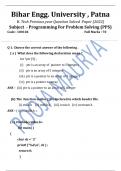Exam (elaborations)
B.Tech First year (PPS) PYQ 2022 Solution
- Course
- Institution
B.Tech first-year programming for problem-solving (PPS) covers fundamental concepts. Topics include variables, data types, and control structures like loops and conditionals. Functions enable modular programming, while arrays and strings handle data efficiently. Recursion offers elegant solutions. ...
[Show more]



